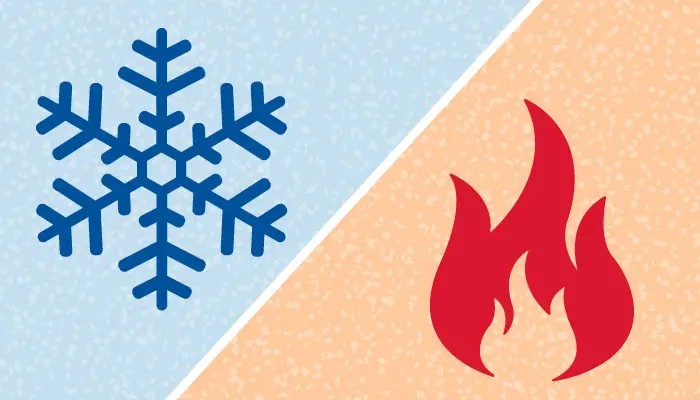La herniated disc is classified as one of the causes of acute and chronic pain today. Treatment via the application of heat or cold is very common in affected individuals. These two techniques contribute to the reduction of muscular tension and to the relief of pain caused by the disease. One wonders which of the two is more effective. Details in this article.
Definition and anatomy
Vertebral column or spine
La spine is composed of vertebrae which form the axial skeleton. It is divided into three parts, including the cervical spine, dorsal spine and lumbar.
Each vertebra is formed by a body (located in front), a posterior arch (consisting of a foramen and bony outgrowths) and by the spinal canal. Each of them is separated by a soft disc who has a pulpy nucleus and fibrous annulus.
In order to support the bones, ligaments attach within the structures of the spine.
The spinal cord articulates with the brain, then travels along the spinal canal. It gives two nerve roots distributed by each foramen. One of the nerve roots transmits sensitivity and the other transmits motor skills, with the contraction of muscles.
Herniated disc: what is it?
herniated disc refers to an abnormality of the soft discs located between the vertebrae and affects the nerve roots. The intervertebral discs crack, expelling the nucleus pulposus towards the posterior arch. This anomaly causes the nerve root compression and induces their irritation.
In turn, the irritated nerve causes tissue inflammation surrounding it (muscle, blood vessels, ligament). This is manifested by pain and tingling that interferes with walking. Muscle weakness also occurs.
This infection affects the cervical and lumbar spine. In the first case, it causes pain and numbness in the neck, shoulders and limbs. In the presence of a lumbar hernia, the symptoms appear on the lower back and radiate to the lower body.
How do you know whether to opt for heat or cold?
Coupled with light muscle strengthening exercises, the techniques offered in physiotherapy are a good remedy for herniated discs. A paramedical treatment that consists of alter body temperature heals muscle aches and bone bruises.
hot and cold are two methods that can be applied successively, on the same day in order to hope for a better result.
Heat: to reduce muscle tension
In thermotherapy, heat is used to relieve muscle tension. It contributes to the relaxation of contracted muscles and reduces the stiffness of the tissues surrounding the irritated nerve. It supplies muscle cells with oxygen and nutrients. This process will repair the tissues while improving muscle recovery.
Applying heat to the areas around the hernia increases blood flow to the small vessels around it. This improves blood circulation while promoting connective tissue elasticity.
To get the day off to a good start, this treatment should be performed on waking up, over a period of 15 minutes. Coupled with small stretching exercises, it can be done several times a day.
In kinesitherapy (physiotherapy), there are several methods such as the infrared lamp, hot compresses, hot baths, sauna and hammam.
The infrared lamp
The massage carried out by certain therapists is used with the help of a infrared lamp.
To do this, the patient lies down at a distance of 30 cm under the lamp, exposing the tense area to it.
La infrared heat locally dilates blood vessels. This stimulates the diffusion of oxygen in the damaged tissues and will eliminate the toxins produced by the tense muscles.
In order to optimize the relief, the massage allows the infrared rays to act in depth. Thus, the therapist manages to manipulate the tissues well to have a better impact on the pain.
The session should not last more than 20 minutes at the risk of excessive exposure to UVB rays. It should be noted that the scientific evidence demonstrating a positive effect of the infrared lamp is limited, although positive results are generally observed in several patients.
The heating patch
Le heating patch is to be applied to the painful area. It contains activated carbon, iron and salt. In the open air, the iron it contains comes into contact with oxygen and releases heat of up to 40 ° C. As for salt and activated carbon, they accelerate the chemical reaction that triggers this heat.
This technique inhibits pain receptors through the minimization of messages of suffering transmitted to the brain.
hot compresses
It exists warm compresses painkiller, namely the hot water bottle, the cushion, the blanket and the lumbar belt heating.
The hot water bottle (where the heating pillow) can be placed under the neck. It promotes the supply of oxygen as well as the dilation of the small vessels located in the part. This will allow the trapezius muscles to relax during or after a long day at work.
It should be placed for at least 20 minutes, with a tolerable temperature. The heat it brings provides immediate relief.
Cold: an excellent remedy against nerve inflammation
La cryotherapy or care by the application of cold is first pain relief. Unlike hot thermotherapy, this technique lowers the local temperature of damaged tissues.
It exerts an anti-inflammatory action and produces an analgesic effect on irritated areas.. It relieves the pain.
In addition, be aware that glycoproteins such as cytokines produce inflammation in the presence of the herniated disc. Extreme cold neutralizes these inflammatory molecules and slows the conduction speed of nerve fibers to the brain. This is what will produce an analgesic and anesthetic effect.
The cryotherapy cabin, the promise of extreme cold
La cryotherapy cabin is an environment immersed in cold that varies between -100 and -110°C.
To test the experience, you should strip naked in the cabin for 3 minutes. This thermal shock slows down the nervous system in the transmission of pain.
Cold compresses
If you do not wish to plunge the body into a bath of ice cubes, there are also electric cold packs. These are applied directly to the painful area. They can be gauged until the optimal degree is obtained.
This equipment is equipped with a safety system which allows it to stop automatically (when you fall asleep or if the temperature is no longer bearable).
A lumbar belt that vaporizes the cold is for example, a material that can be applied directly to the lower back. The application can be done every day, after performing some recovery exercises. A treatment lasts 15 minutes and can be alternated with heat.
References
https://public.larhumatologie.fr/rachis-colonne-vertebrale-fiche-anatomie


